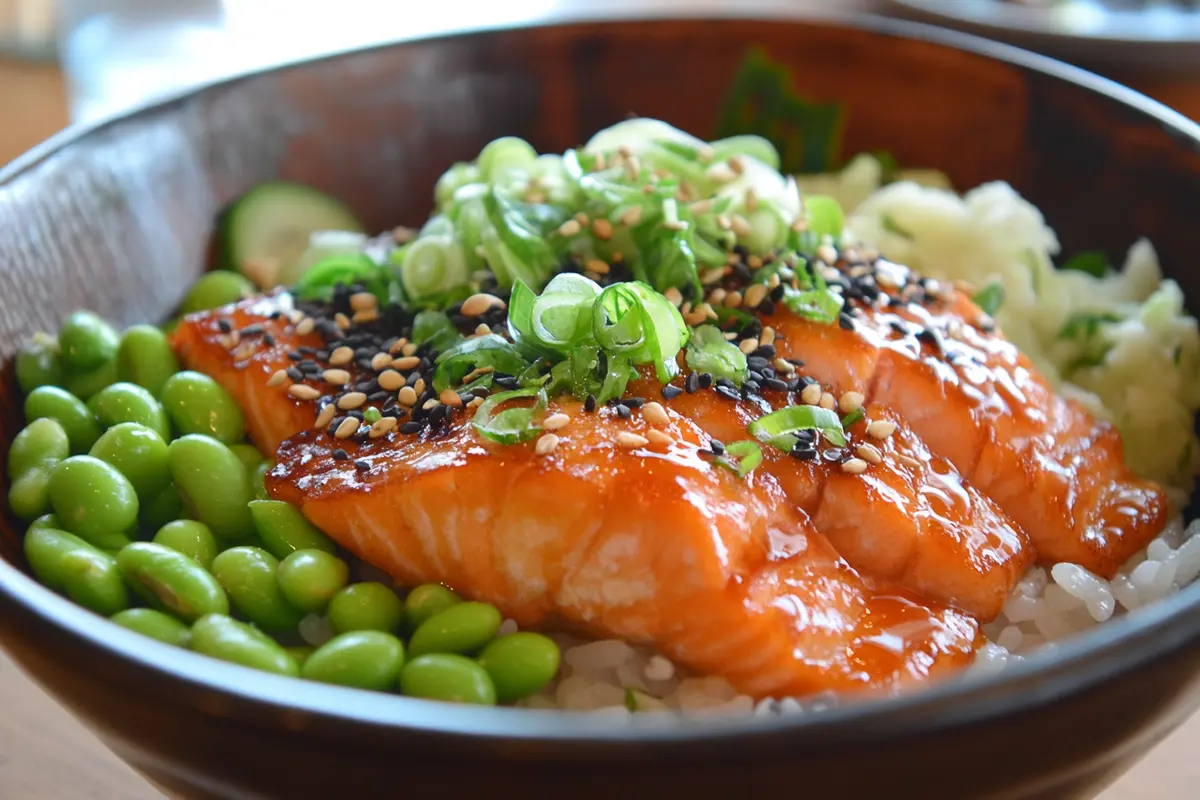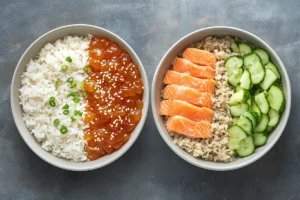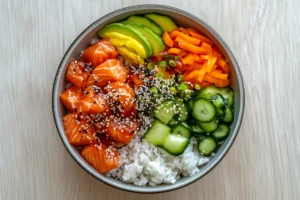Want to know how many calories in a teriyaki salmon rice bowl? This guide breaks down the calorie count and offers healthy tips.
Figuring out how many calories in a teriyaki salmon rice bowl is essential for those watching their diet. This popular dish combines the protein-rich salmon with carbohydrates from rice and flavor from teriyaki sauce. However, the exact calorie count can vary significantly. Therefore, understanding the factors that influence this number is helpful. In addition, knowing the approximate calories helps with meal planning.
Factors Affecting the Calorie Count
Several factors determine how many calories in a teriyaki salmon rice bowl.
-
Portion Size: Larger portions naturally contain more calories.
-
Type of Rice: Brown rice has slightly fewer calories than white rice.
-
Teriyaki Sauce: Some sauces are higher in sugar and, therefore, higher in calories.
-
Salmon Type: Different types of salmon have varying fat contents, affecting the calories.
-
Added Toppings: Toppings like avocado, sesame seeds, and vegetables add to the total calorie count.
-
Cooking Method: Baking, grilling, or pan-frying salmon can alter the calories slightly.
Breaking Down the Calories: Salmon, Rice, and Sauce
To accurately estimate how many calories in a teriyaki salmon rice bowl, let’s break down the main components:
-
Salmon (4 oz): Approximately 200-250 calories.
-
White Rice (1 cup cooked): Around 200-220 calories.
-
Brown Rice (1 cup cooked): About 215 calories.
-
Teriyaki Sauce (2 tablespoons): Roughly 50-80 calories.
-
Total Estimated Calories: Ranging from 450 to 550 calories for a standard serving.
Keep in mind that these numbers are approximate and can vary based on specific brands and recipes. Therefore, it is always best to check the nutritional information on the products you use.
How Many Calories in a Teriyaki Salmon Bowl from Restaurants?
When ordering a teriyaki salmon bowl from a restaurant, how many calories can you expect? Restaurant portions often differ from homemade meals. They tend to be larger and may contain more teriyaki sauce or added ingredients. Consequently, a restaurant teriyaki salmon bowl could easily contain 600-800 calories or more. Some restaurants provide nutritional information online; therefore, check their websites.
Making a Lower-Calorie Teriyaki Salmon Rice Bowl at Home
If you’re mindful of calories, making a teriyaki salmon rice bowl at home is a great option. Here are some tips to reduce the calorie count:
-
Choose Lean Salmon: Opt for salmon with lower fat content, such as sockeye or pink salmon.
-
Use Brown Rice: Brown rice is higher in fiber and slightly lower in calories than white rice.
-
Control the Sauce: Make your own teriyaki sauce with less sugar.
-
Load Up on Vegetables: Add plenty of non-starchy vegetables like broccoli, spinach, or bell peppers.
-
Portion Control: Use measuring cups to ensure you’re not overeating.
Health Benefits of Teriyaki Salmon Rice Bowls
Despite the calorie content, teriyaki salmon rice bowls offer several health benefits. Salmon is an excellent source of omega-3 fatty acids. These healthy fats support heart health and brain function. In addition, it’s rich in protein, essential for muscle building and repair. Brown rice provides fiber, which aids digestion and helps you feel full longer. Furthermore, adding vegetables boosts the nutrient content.
Nutritional Information of Key Ingredients
Here’s a more detailed look at the nutritional information of the key ingredients:
-
Salmon (3 oz cooked):
-
Calories: Approximately 175
-
Protein: 19 grams
-
Fat: 10 grams (including omega-3 fatty acids)
-
Vitamin D: Significant amount
-
-
White Rice (1 cup cooked):
-
Calories: Approximately 205
-
Carbohydrates: 45 grams
-
Protein: 4 grams
-
Fiber: Less than 1 gram
-
-
Brown Rice (1 cup cooked):
-
Calories: Approximately 215
-
Carbohydrates: 45 grams
-
Protein: 5 grams
-
Fiber: 3.5 grams
-
-
Teriyaki Sauce (2 tablespoons):
-
Calories: Approximately 60
-
Sugar: 10-15 grams
-
Sodium: Significant amount
-
Comparing Calorie Counts: Different Rice Types
The type of rice you choose can impact how many calories are in a salmon and rice bowl.
-
White Rice: Provides quick energy but is lower in fiber. A cup has around 205 calories.
-
Brown Rice: Offers more fiber, leading to better satiety and blood sugar control. A cup contains about 215 calories.
-
Quinoa: A grain substitute that’s high in protein and fiber. A cup has roughly 220 calories.
-
Cauliflower Rice: A low-carb option with minimal calories. One cup has approximately 25 calories.
Tips for Measuring Food Portions Accurately
Accurate portion control is key to managing calories. Here are some tips:
-
Use Measuring Cups and Spoons: Invest in a set of measuring tools for consistent portions.
-
Weigh Your Food: A food scale provides the most accurate measurements.
-
Read Labels: Pay attention to serving sizes listed on food packaging.
-
Pre-Portion: Divide meals into individual containers to avoid overeating.
-
Be Mindful: Pay attention to your body’s hunger and fullness cues.
Healthy Topping Options for Your Bowl
Choose toppings that add flavor and nutrients without excessive calories:
-
Green Onions: Adds a fresh, mild flavor with minimal calories.
-
Sesame Seeds: Provides healthy fats and a nutty flavor.
-
Avocado (small amount): Offers healthy fats and a creamy texture, but is calorie-dense, so use sparingly.
-
Edamame: A good source of protein and fiber.
-
Steamed Vegetables: Broccoli, carrots, and spinach are low-calorie and packed with vitamins.
How Many Calories Are in a Salmon and Rice Bowl with Variations?
The calorie count in a salmon and rice bowl varies with ingredients. For instance, a spicy salmon bowl might include mayonnaise or sriracha, increasing calories. Similarly, adding tempura vegetables or creamy sauces significantly boosts the total calorie count. Therefore, consider these additions when estimating how many calories are in a salmon and rice bowl.
How Many Calories Are in a Teriyaki Rice Bowl Alone?
If you’re only having a teriyaki rice bowl, the calorie count mainly depends on the rice and sauce. A bowl with one cup of white rice and two tablespoons of teriyaki sauce contains approximately 265-285 calories. Brown rice will have a similar calorie count, however it offers more fiber. Therefore, how many calories are in a teriyaki rice bowl largely depends on the ingredients.
Calorie Calculation for Different Teriyaki Sauces
The teriyaki sauce can significantly affect the calorie content.
-
Store-Bought Sauce: Often high in sugar and sodium, with about 50-80 calories per two tablespoons.
-
Homemade Sauce (low-sugar): By reducing sugar, you can lower the calories to approximately 30-50 per two tablespoons.
-
Honey-Based Sauce: Using honey instead of sugar can provide a slightly lower calorie option.
-
Low-Sodium Sauce: Reduces sodium intake without affecting the calorie count drastically.
Exercise and Calorie Balance: Burning Off the Calories
To maintain a healthy weight, balance calorie intake with physical activity. Here are some activities and their approximate calorie burn per 30 minutes (for a 150-pound person):
-
Walking (3.5 mph): Approximately 140 calories
-
Jogging: Around 295 calories
-
Cycling: Roughly 220 calories
-
Swimming: About 255 calories
Therefore, if you consume a 500-calorie teriyaki salmon rice bowl, engaging in one of these activities can help burn off those calories.
Benefits Recipes
Consuming a teriyaki salmon rice bowl can be beneficial:
-
Omega-3 Fatty Acids: Salmon is rich in omega-3s, promoting heart and brain health.
-
High-Quality Protein: Salmon provides essential amino acids for muscle development.
-
Fiber: Brown rice contributes to digestive health and helps regulate blood sugar levels.
-
Essential Nutrients: The dish offers vitamins and minerals from both salmon and added vegetables.
-
Balanced Meal: A teriyaki salmon rice bowl combines protein, carbohydrates, and healthy fats for sustained energy.
Nutritional Information
Nutritional content (per 100g) of teriyaki salmon rice bowl
| Nutrient | Amount |
|---|---|
| Calories | Approx. 220 |
| Protein | Approx. 18g |
| Fat | Approx. 12g |
| Carbohydrates | Approx. 10g |
| Fiber | Approx. 1g |
| Sugar | Approx. 5g |



